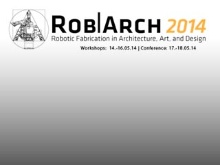This workshop will explore robotic winding strategies for light-weight, fiber-composite building components.
Fiber-reinforced polymers (FRP) possess a number of characteristics such as a high load-bearing capacity combined with minimal self-weight, which have made them the preferred choice for structural applications in a variety of engineering fields ranging from automotive to ship-building to aerospace. The performative nature of these material systems is further enhanced through design considerations at the scale of material organization which allows for a higher degree of material efficiency and morphologic articulation in light-weight constructions. Such a system requires the fabrication of complex geometries with precisely controlled fiber orientation — a difficult process to achieve on an architectural scale using traditional modes of fabrication. Existing manufacturing techniques for FRP rely on costly formwork for serial production of identical elements or complex adaptable formwork for one-off production. Neither of these strategies seems applicable to the building industry. Coreless winding strategies developed for the ICD/ITKE Research Pavilions reduces the necessity for formwork to a minimum while providing a high degree of freedom for geometrically differentiated building components.
The fabrication setup for highly differentiated fiber composite components consists of two industrial robots, Kuka KR60s will be used for the workshop, which are kinematically linked to operate as one 12 axis robotic system. This provides the necessary degrees of freedom to produce a wide range of component geometries. For synchronization of the two robots, participants will use Kuka RoboTeam software while robotic control, simulation, and development of winding strategies and component design will be based on design tools developed by the ICD.
Coreless FRP systems rely on several fiber winding strategies to ensure proper fiber-fiber interaction for fabrication (e.g., frame geometry, fiber tension and winding syntax — the systematic sequence of fiber placement). The frame geometry is defined by design strategies as well as fabrication constraints of the coreless winding process. Variations in winding syntax can be calibrated to create the geometrical scaffolding for each components as well as the enclosure and structural reinforcing. Fiber tension is dependent on the robotic control, winding speed and material resistance.
Participants will be introduced to the robotic fabrication of fiber composite building components by providing them with the opportunity for first-hand experience with a 12-axis robotic fabrication setup. Starting from the digital design of a prototype including fiber organization at the material level, participants will be exposed to all the digital data processing steps (‘digital chain’) from CAD to CAM through to fabrication using Rhino & Grasshopper. Basic familiarity with the tools is highly encouraged.
During the workshop participants will work in small teams focusing on the design of the fiber syntax and the robotic production of a light-weight fiber composite building component. The idea is to quickly implement the computational design tools developed by the ICD research team in order to arrive at a joint prototype composed of each team’s component with a specific design which is developed commonly by the workshop group using and exploring the different aspects of fiber syntax and robotic winding fabrication in combination. On Day 1 the digital tools will be introduced in detail and consequently handed out to the individual groups so that design parameters can be calibrated. The results of the individual groups will be synthesized to build a common prototype that will be exhibited at the RobARCH 2014 Conference in Ann Arbor.
Location: University of Michigan
Participants will be introduced to fiber placement strategies, robotic simulation and KRL code generation inside a Rhino 5/Grasshopper workflow. Participants will work together to develop a small, lightweight fiber prototype system. Individuals or small groups of participants will fabricate and assemble components of the system during the 3-day workshop.
Basic knowledge with Rhino 5.0.
Familiarize yourself with Python 101 Primer
Familiarize yourself with Grasshopper Primer
Participants are required to bring their own laptops with a working copy of Rhino 5.0, Grasshopper, and GhPython.
- 2x Kuka KR60 6-Axis Industrial Robots
Day 1
09:30 Introduction of workshop by the presenters
10:15 Formation of working teams
10:30 Distribution of computational tools to participants and demonstration of workflow
11:00 Development of fiber winding strategies and prototype production
17:00 Review
Day 2
9:30 Production of prototypes
18:00 Review
Day 3
9:30 Production of prototypes (if needed)
17:00 Construction of prototype in exhibition
The workshop is fully booked!


